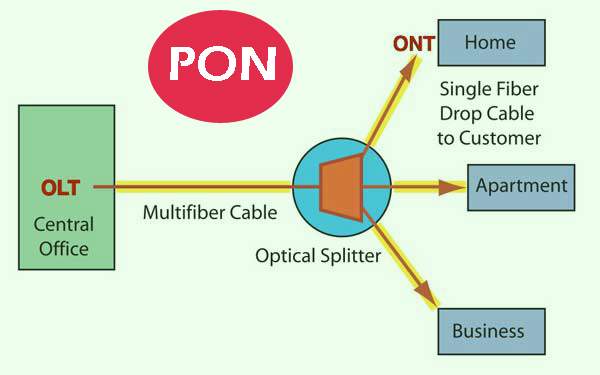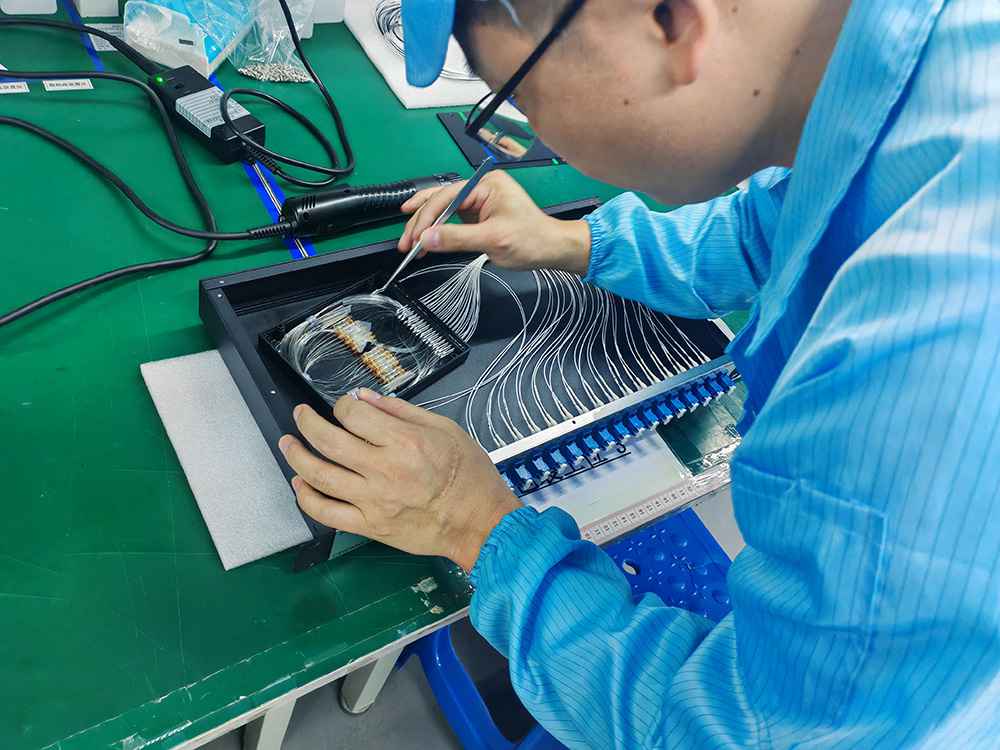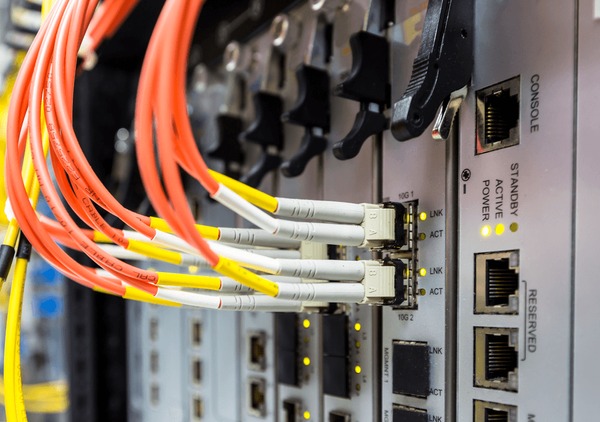GPON stands for Gigabit passive optical network, which is the latest generation of broadband passive optical integrated access standard based on ITU-TG.984.x standard. It has many advantages such as high bandwidth, high efficiency, large coverage, and rich user interfaces. It is regarded by most operators as an ideal technology for realizing broadband and integrated transformation of access network services.
GPON Core Structure
GPON adopt point-to-multipoint (P2MP) structure, and it consists of 3 parts: ONU, OLT and passive optical distribution network (ODN).
- OLT (optical line terminal)
OLT located in the operator’s computer room, it is the “brain” of the network.
Function: it control the bandwidth allocation of the entire network, manage user terminals (ONU), connect to the upper-layer IP network, and real-time monitoring, operation and maintenance management of the PON system.
The system supports 1:16, 1:32, 1:64 splitter in gpon, maximum up to 1:128 splitters in fiber optics.
Passive optical fiber distribution network no need power supply, the core is the gpon splitter.
Function: Distribute the downstream optical signal of OLT to multiple ONUs and aggregate the upstream signal of ONUs.
- ONU / ONT (optical network unit / terminal)
ONU Convert optical signals into electrical signals for use in computers, mobile phones, etc, it provides a user-side interface for the access network with multiple service flows such as voice, data, and video. ONT directly serves home users, and ONU can be used for multi-user access in enterprises.

GPON key technology
Downstream: OLT uses 1490nm wavelength to send data to all ONUs.
Upstream: ONU uses 1310nm wavelength to transmit data back (to avoid signal conflicts).
Optional: 1550nm wavelength is used to transmit TV signals (CATV network).
- Passive Splitting
The passive splitter passively splits the optical signal without no power supply, typical splitting ratio are 1:32, 1:64 (up to 1:128 available).
Advantages: Reduce operation and maintenance costs and improve reliability.
- Dynamic Bandwidth Allocation (DBA)
OLT monitors ONU needs in real time and dynamically allocates upstream bandwidth (to avoid network congestion).
- Encryption Mechanism
Downstream broadcast data is encrypted using AES-128 to prevent data eavesdropping between users.
GPON network features
- GPON provides 2.5Gbps high bandwidth to meet future needs, and its asymmetric characteristics are suitable for the broadband market, the actual user shares the bandwidth, but it is much higher than ADSL/coaxial cable.
- GPON supports ATM/GEM dual-mode bearer, provides full-service access capabilities with QoS guarantee, and can natively encapsulate any service. Its technology is mature and the cost decreases with scale.
- GPON perfectly supports TDM services and guarantees QoS real-time transmission through dual-mode bearer of GEM frames (125μs synchronization) and ATM cells.
- GPON’s GEM technology achieves efficient adaptation of multiple services (94% encapsulation efficiency) through flexible frame encapsulation, carries Internet access, IPTV, voice (VoIP), enterprise dedicated lines, etc at the same time, which reduces protocol conversion and improves bandwidth utilization compared to APON/EPON.
- GPON provides carrier-grade OAM capabilities by embedding three channels: OAM, PLOAM and OMCI, making up for the lack of Ethernet management and realizing efficient control/management plane.
- GPON has high equipment costs due to technical complexity, but large-scale applications will drive costs down. Furthermore, ODN passive devices do not require power supply, have a low failure rate, and are easy to maintain, so the operation and maintenance costs are lower.
- Fiber optic cables are resistant to electromagnetic interference, data transmission is difficult to eavesdrop on, and have high security.
- GPON can support 20km transmission and a maximum logical distance of 60km.
What is the difference between GPON and EPON?
The transmission mechanism of GPON is exactly the same as that of EPON, both of which use a single-fiber bidirectional transmission mechanism, that is on the same optical fiber, WDM (wavelength division multiplexing) technology is used to transmit upstream and downstream data at different wavelengths to achieve bidirectional transmission of signals. We can use PON protection structures to improve the survivability of the network if need.
The main difference is as below table:
| Parameters | GPON | EPON |
| Standard setting | ITU-T (G.984) | IEEE (802.3ah) |
| Bandwidth | Downlink 2.5Gbps, Uplink 1.25Gbps | Symmetrical 1.25Gbps for uplink and downlink |
| Split ratio | Up to 1:128 splitter | Usually 1:32 splitter |
| Management protocol | OMCI (Dedicated Management Channel) | OAM (Extended Ethernet Protocol) |
| Main applications | Global mainstream (especially Europe, America and Asia) | Mostly used in China in the early days |
TREND: 10G-PON (XG-PON) has been gradually put into commercial use, it is compatible with existing GPON ODN, and has increased bandwidth to 10Gbps.
Typical application of GPON
GPON can be applied to fiber to the home, fiber to the building, fiber to the roadside and fiber to the junction box in the access network.
1. FTTB for Business
Symmetrical broadband services (such as Group Software, Content Broadcast, E-mail, file interaction, etc.) POTS and ISDN dedicated lines (GPON must be able to flexibly provide dedicated line services at different rates).
2. FTTC and FTTCab
Asymmetric broadband services (such as digital broadcasting services, VOD, IPTV, file downloads, online games, etc.) ;
Symmetrical broadband services (such as Content Broadcast, E-mail, file interaction, distance education, remote diagnosis, etc.) POTS and ISDNxDSL extension.
3. FTTH for home users
Asymmetric broadband services (such as digital broadcasting services, VOD, IP TV, file downloads, etc.);
Symmetrical broadband services (such as Content Broadcast, E-mail, file interaction, distance education, remote diagnosis, online games, etc.)
4. 5G fronthaul network
Carrying data transmission between base station (AAU) and central unit (DU).
5. Smart city
Provides massive connections for IoT devices such as cameras and sensors.
Optical parameters of GPON network
GPON can provides the following transmission rates, among them, 1.24416Gbps upstream and 2.48832Gbps downstream are the main rates currently supported.
| Uplink | Downlink |
| 0.15552Gbps | 1.24416Gbps |
| 0.62208Gbps | 1.24416Gbps |
| 1.24416Gbps | 1.24416Gbps |
| 0.15552Gbps | 2.48832Gbps |
| 0.62208Gbps | 2.48832Gbps |
| 1.24416Gbps | 2.48832Gbps |
| 2.48832Gbps | 2.48832Gbps |
It should be noted that unlike EPON, GPON is not completely asynchronous.
- The maximum logical distance supported is: 60km
- The maximum physical distance supported is: 20km
- The maximum distance difference supported is: 20km
- The splitting ratio is generally 1:64. Currently, the splitting ratio of fiber optic splitter manufacturers can be upgraded to 1:128.
Limitations of GPON
– Shared bandwidth: User peak rate is affected by other user traffic on the same PON port.
– Difficulty in fault location: The passive nature of ODN makes it difficult to remotely detect fiber breakpoints.
– Upgrade cost: Evolution to 10G-PON requires replacement of OLT boards and ONUs.
Conclusion
GPON is essentially a technology that uses a single fiber truck cable to serve multiple end users through a passive optical splitter. Its high bandwidth, low cost, and easy scalability make it a cornerstone technology in the era of fiber-to-the-home. With the popularization of applications such as XR (extended reality) and AIoT, GPON will continue to evolve to higher speeds (such as 50G-PON) to support digital needs in the next decade.
FAQ
What is the difference between GPON and FTTH?
GPON is a network technology standard, which is applicable to various access modes, including FTTH, FTTB (fiber to the building), etc. While FTTH is a specific access method which bring fiber to the home subscribers.
What is the difference between GPON and active fiber?
GPON is a Gigabit passive optical network technology with a transmission distance of generally less than 20 km, suitable for use in FTTH and FTTB scenarios, and does not require additional power supply. Active fiber transmission distance can reach 100 km, suitable for long-distance communication, but requires additional power supply equipment, which increases complexity and cost.
Does GPON use Ethernet?
GPON does not use Ethernet. GPON (Gigabit Passive Optical Network) is based on the ITU-T G.984 standard and does not use Ethernet technology.
What comes after GPON?
GPON’s future evolution direction is 10G GPON and XG-PON (50G PON), please check blog: What is XGS-PON, GPON and XG-PON?
What is a WAN port?
WAN port (Wide Area Network port) refers to the physical interface or port used to connect to the Wide Area Network in a network device. WAN port is used to communicate with the external network, while LAN port is used for device interconnection and resource sharing within the local area network.
What is the maximum distance that can support by a GPON technology?
GPON technology can support a max distance of 60 km, which is the max supported range under ideal conditions. In actual applications, due to factors such as fiber quality and splitting ratio, it is usually difficult to achieve stable transmission over 60 km but physical transmission distance within 20km.
Is GPON better than Ethernet?
It depends. GPON is more suitable for application scenarios that require high quality of service (QoS) guarantees, such as hybrid services of voice, video, and data services.
Ethernet performs better in pure IP environments and enterprise networks. The high bandwidth characteristics of 10G EPON ensure better in large data transmission requirements, such as high-definition video streaming, cloud services, and enterprise-level high-speed Internet access
How do I know if I have GPON or EPON?
For our users, the fastest way is to check the fiber interface mark, E=Ethernet, G=GPON; or you can find answer on the device user manual ”EPON” or “GPON”.





